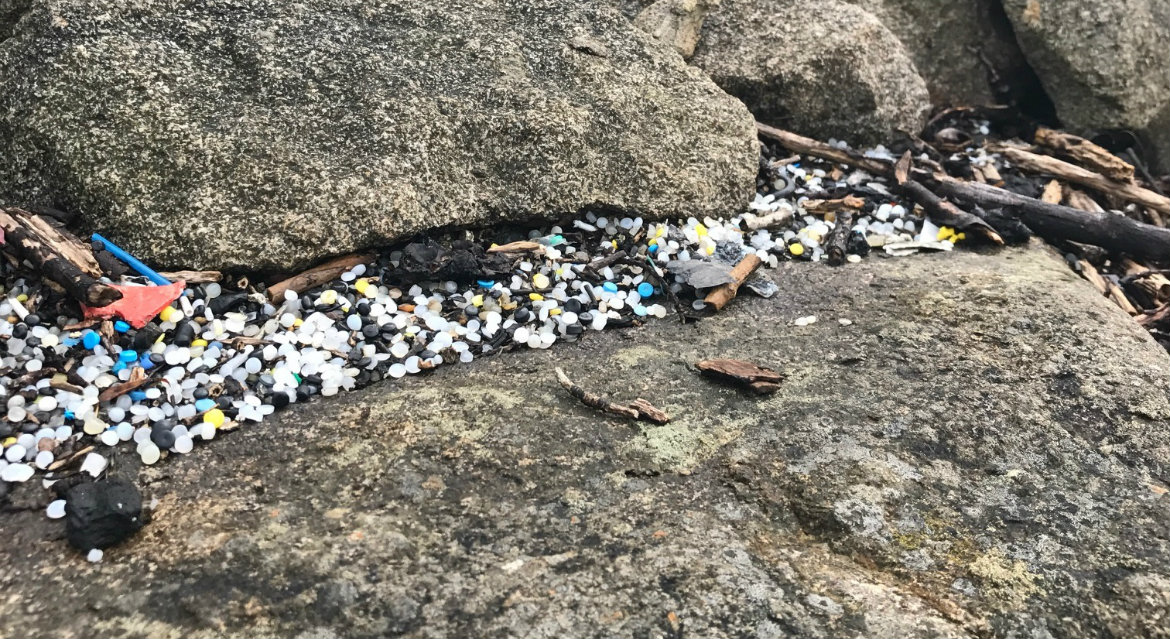‘Disturbing’ scale of plastic pollution revealed
Published On Thu 9 May 2019 by Grant Hill

Research carried out at the University of Dundee has shown the scale of plastic pollution in the Firth of Forth to be much worse than previously thought.
The study was carried out by Suzanne Grimes as part of her undergraduate dissertation last year. After examining 16 coastal locations either side of the Forth estuary, she retrieved a total of 20,281 pieces of plastic from a total area of just 48m2.
Worryingly, 71.51% of this pollution was in the form of nurdles, small plastic pellets about the size of a lentil that are melted down to make plastic products. The area is home to plastics manufacturers, suggesting that mishandling in the industrial process is causing large numbers of these nurdles to find their way onto our shores and pose a major threat to birds and marine life.
Bo’ness was the single most polluted of the sites Suzanne studied, with 9671 pieces of primary plastic and 4894 pieces of secondary plastic removed from an area 3m2 and just 2cm deep. On average, 1,268 pieces of microplastic (primary and secondary) were found at each location.
Suzanne, who graduated with a degree in Environmental Science last year, said, “I was absolutely shocked by what I found when I started this project. I didn’t expect to find so many heavily polluted areas. It was overwhelming and disturbing.
“What I found was worse than any previous attempts to gauge the scale of the plastic pollution problem had shown. Inspections take place but these are announced ahead of time so areas can be cleaned up. When you conduct a survey at random a different picture emerges.
“When you walk onto a beach you can see there is clearly so much more pollution out there but you choose the sites you will study beforehand so you are not prejudiced by what you see when you arrive. At each of these 16 locations I put a m2 quadrat down and dug down 2cm. This was done at three different spots at each location. The fact I found so much plastic gives you some idea of how bad the situation is across the whole Forth estuary.
“I expected to find a lot of plastic bags, bottles, cotton buds and things like that because there’s been so much publicity about them, but the nurdles really shocked me. It’s impossible to say how bad the situation is, but you must be talking about millions of pieces in the Firth of Forth. I live in Fife and used to take my children to beaches here but I wouldn’t do that now having found what I have.
“Something needs to be done about this. We are meant to have a polluter-pays principle when it comes to dealing with pollution, but the manufacturer is only liable until the goods leave the factory. Then it is down to the transport company. And when it gets into drains someone else again. Millions of pieces of primary plastic are finding their way onto our beaches and into our water and no one is taking responsibility.”
Suzanne hopes to return to the University to further develop her research as part of a Masters degree in Marine Hydrodynamics and Ocean Engineering looking at the prevalence of these plastic pieces in our rivers and seas.
She first became interested in plastic pollution in classes taught by Dr Alison Reeves, who says that while awareness of the harms caused by plastics has never been higher thanks to series like Blue Planet, the amount of plastic in the environment continues to grow.
“I have been teaching about plastic in the UK for as long as I can remember but even I was shocked by what Suzanne found,” she said. “There are lots of plastic manufacturers and industrial companies in the Firth of Forth area and this is a serious form of diffuse pollution.
“Removing nurdles is not like getting rid of metals. You can’t use a magnet. Currently there is no alternative but to sieve and physically pick them up. Once they get into the environment they are hard to remove.
“Larger pieces of plastic are relatively easy to remove but these tiny pieces are being eaten by birds and marine life and it lodges in their digestive systems. They do not have the enzymes in their intestines to reduce the size of the pellets and birds and marine mammals starve to death as their guts remain full of indigestible material.”
For media enquiries contact:
Grant Hill
Press Officer
University of Dundee
Nethergate, Dundee, DD1 4HN
Tel: +44 (0)1382 384768
Mobile: 07854 953277
Email: g.hill@dundee.ac.uk